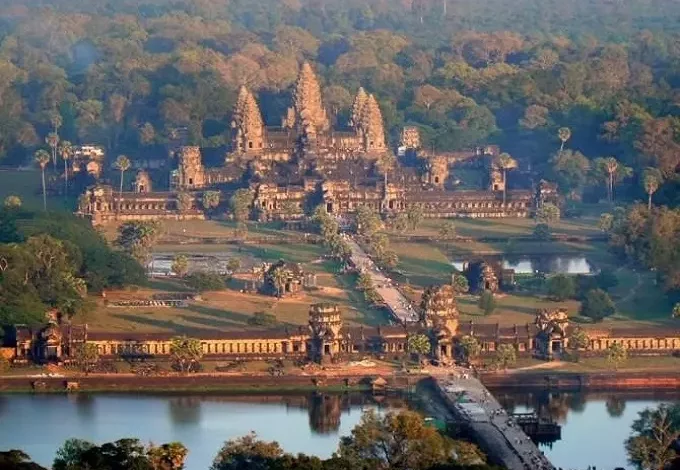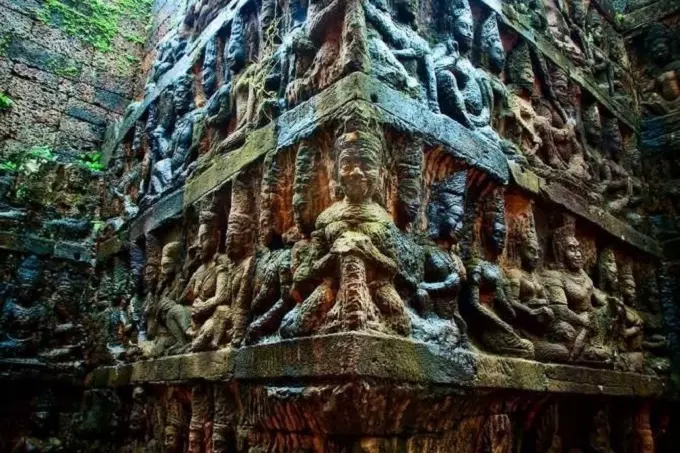Who built Angkor Wat?

The huge Angkor Wat temple complex is the main symbol of Cambodia and is even depicted on the flag of this country. Cambodians are proud that their Khmer ancestors were able to build such a wonder of the world, not inferior in splendor to other famous architectural monuments. European researchers, studying the temple, often wondered if the Khmers had appropriated someone else’s merits for themselves.
In 1858, the French naturalist Henri Mouot went to Indochina to collect scientific information about Cambodia, Laos, and Siam. Arriving in the Cambodian city of Siem Reap, he decided to explore its surroundings. Henri found himself in the depths of the jungle and, after a few hours, realized that he was lost.
After several days of wandering in the jungle, Muo saw three stone towers resembling beautiful lotus buds in the rays of the setting sun. Coming closer, Henri saw a moat with water, and behind it, a huge stone fence in elaborate carvings depicting gods, people, and animals. Behind it towered buildings of extraordinary size and beauty.
The Lost Traveler
“The monuments of construction art I have seen are huge in size and, in my opinion, are an example of the highest level compared to any monuments preserved since ancient times,” Muo wrote in the book “Journey to the Kingdoms of Siam, Cambodia, Laos and other areas of central Indochina.” – “I have never felt so happy as I do now, in this magnificent tropical setting. Even if I had known that I would have to die, I would never have exchanged this life for the pleasures and comforts of the civilized world.”
Deciding that there was an ancient castle or temple in front of him, the Frenchman began to shout for help. It turned out that Buddhist monks lived in the majestic building. They saved Muo, who was already dying of malaria and starvation.
When Henri got better, the monks told him that he was in the greatest temple in Cambodia, which is called Angkor Wat. The Europeans knew nothing about it. Although back in 1550, the temple was visited by the Portuguese Diogo do Couto, who published notes about his journey.
In 1586, another Portuguese, the Capuchin monk Antonio da Madalena visited Angkor Wat and left written evidence about it: “This is such an unusual structure that it is impossible to describe it with a pen, especially since it is unlike any other building in the world. It has towers, decorations, and all the subtleties that human genius can only imagine.”

And in 1601, the Spanish missionary Marcelo Ribandeiro and Muo, who got lost in the jungle, came across this majestic temple. Europeans also visited Angkor Wat in the 19th century. The same Henri Mouot writes that five years before him, the French missionary Charles-Emile Bouilleveau visited there, who published an account of this journey in 1857. But the descriptions of Buyevo and his predecessors did not catch the attention of the public. So it was the book by Henri Mouot, published in 1868, that made Angkor Wat famous.
The center of the Universe
Angkor Wat Temple is a complex of buildings located on a rectangular plot of 200 hectares. Behind the stone wall, as archaeologists suggest, there was not only a temple, but also a royal palace and other buildings. But since these buildings were built of wood, they have not been preserved.
The temple itself symbolizes the sacred Mount Meru – “the center of the universe and the abode of the god” in Hindu mythology. The five-towered temple looks most beautiful during the rainy season, when the 190-meter moat is filled with water. Then Angkor Wat looks like the center of the universe surrounded by the waters of the World Ocean. This is exactly how the creators intended it.
The three-stage temple itself with pointed towers is a triumph of symmetry. Once in it, a person immediately sees the entire structure, which rises on three terraces standing on top of each other. It seems as if the temple grows before the eyes of an approaching person. This effect was possible due to the location of the terraces. The first terrace rises 3.5 meters above the ground, the second – 7 meters, and the third – 13 meters. At the same time, each is surrounded by galleries covered with gable roofs.
No matter from which side a visitor approaches Angkor Wat, he always sees only three towers. The height of the central one is 65 meters. Considering that all this splendor is covered with hundreds of sculptures and reliefs with images from ancient Indian epics – Ramayana and Mahabharata, one can only admire this creation of human hands.
The biggest city
Once the temple of Angkor Wat was located in the heart of the Khmer Empire – the city of Angkor. At the same time, “Angkor” is not a historical name. It spread later, when these places were abandoned by the Khmer rulers, and then fell into decline. The Khmers began to call this place simply “the city” – in Sanskrit “nagara”, later transformed into “Angkor”.
At the very beginning of the IX century, the Khmer emperor Jaya-Varman II began the construction of the first religious building in these places. For 400 years, Angkor has grown into a giant city consisting of more than 200 temples. The main one was Angkor Wat. Historians attribute its construction to Emperor Suryavarman II, who ruled from 1113-1150.

The ruler was considered an earthly incarnation of Vishnu, and the Khmer worshipped him as a living deity. And the temple, being a symbol of the heavenly palace, served as a refuge for the ruler’s spirit and his future tomb.
Angkor Wat has been under construction for more than 40 years. The temple, which exceeds the entire Vatican in area, was built by tens of thousands of workers and stonemasons. The construction was completed after Suryavarman’s death, but the tomb was ready at the time of his death.
In 2007, an international expedition conducted a study of Angkor using satellite photos and other modern technologies. As a result, it was concluded that Angkor was the largest city of the pre-industrial era. Angkor measures 24 kilometers from west to east and 8 kilometers from north to south.
At the peak of its development, a million people lived here – an unthinkable figure for those years. To provide such a mass of people with food, the Khmers built a complex hydraulic system capable of feeding both agricultural land and serving as a source of water. In addition, this system protected Angkor from flooding during the rainy season.
In 1431, Siamese troops captured Angkor and ravaged it. Having lost the capital’s status and the opportunity to develop, the city began to fade away, and people left it. A hundred years later, the jungle turned Angkor into an abandoned place. However, both Angkor and Angkor Wat have never been completely deserted.
Legends and fantasies
Where did the assumptions come from that Angkor Wat is much older than its official age? There are several reasons for this. If you look at the satellite photo of Angkor, you can see that the structure of the temple complex reproduces the position of the stars of the constellation of the Dragon at dawn on the day of the vernal equinox in 10,500 BC.
The Khmers have a beautiful legend about this. Once a royal couple had a child who was the son of the supreme deity, Indra. When the boy turned 12 years old, Indra came down and took him to himself, to Mount Meru. Despite the love of the deity for the prince, the heavenly virgins began to grumble that a person is subject to temptations and must be brought back.
For the sake of maintaining peace in the heavenly abode, Indra decided to send the boy to earth. In order for the prince to remember Meru, Indra wanted to give him a copy of his palace. But the humble boy said that he would be happy to live in Indra’s cowshed. Then the deity sent a talented architect to the prince, who built the magnificent Angkor Wat, which was a copy of the cowshed of the deity.
A different hypothesis was put forward by the Spanish missionary Marcelo Ribandeiro, who saw Angkor Wat in 1601. Knowing that traditions did not allow the Khmer to build stone buildings, he approached this logically: “The world learned all the best from the Hellenes and Romans.”
What he wrote in his book: “There are ruins of an ancient city in Cambodia, which, according to some, was built by the Romans or Alexander the Great. It is noteworthy that none of the natives can live in these ruins, and they serve as a refuge for wild animals. These pagans believe, according to tradition, that the city should be restored by a foreign people.”




